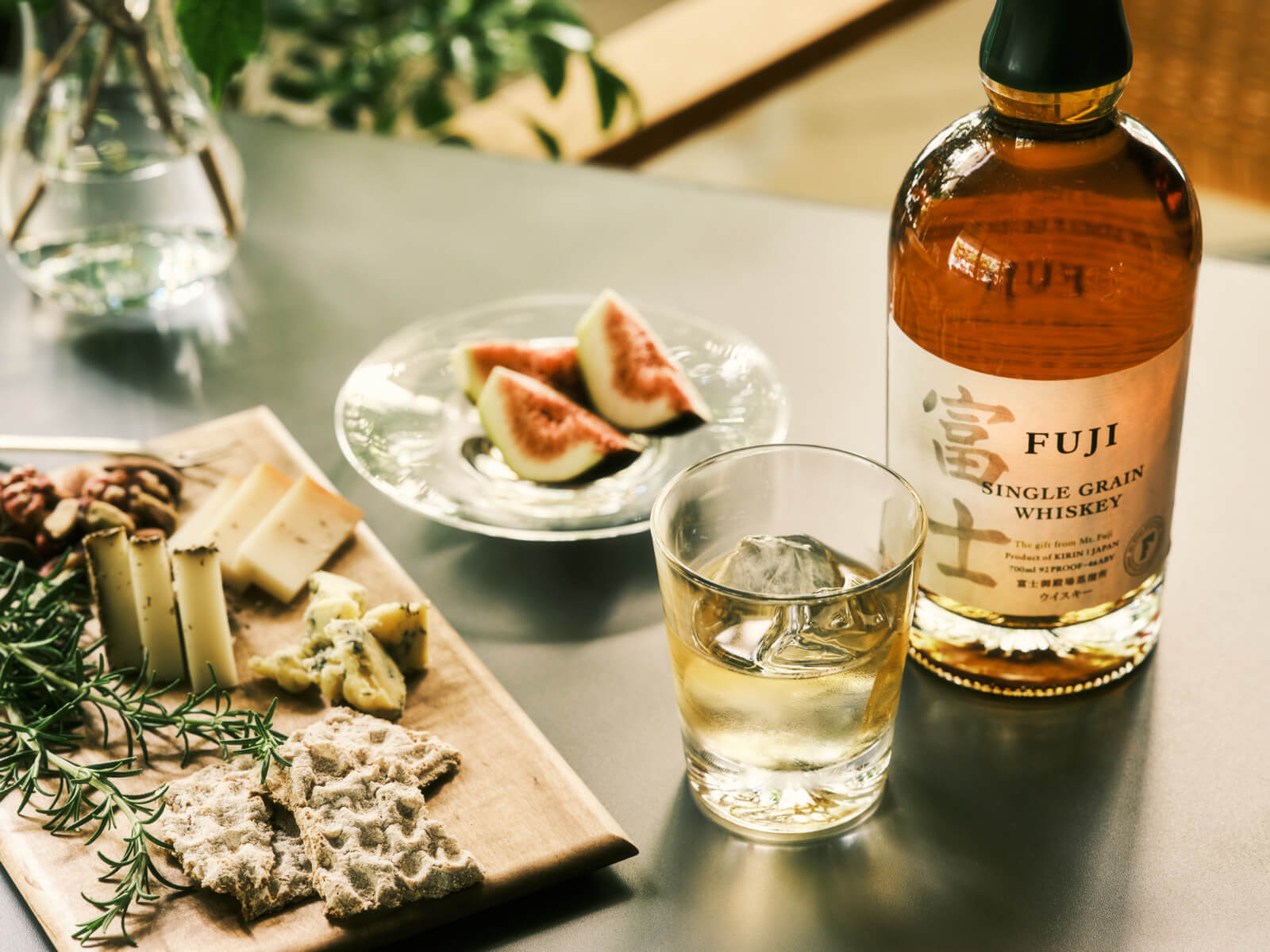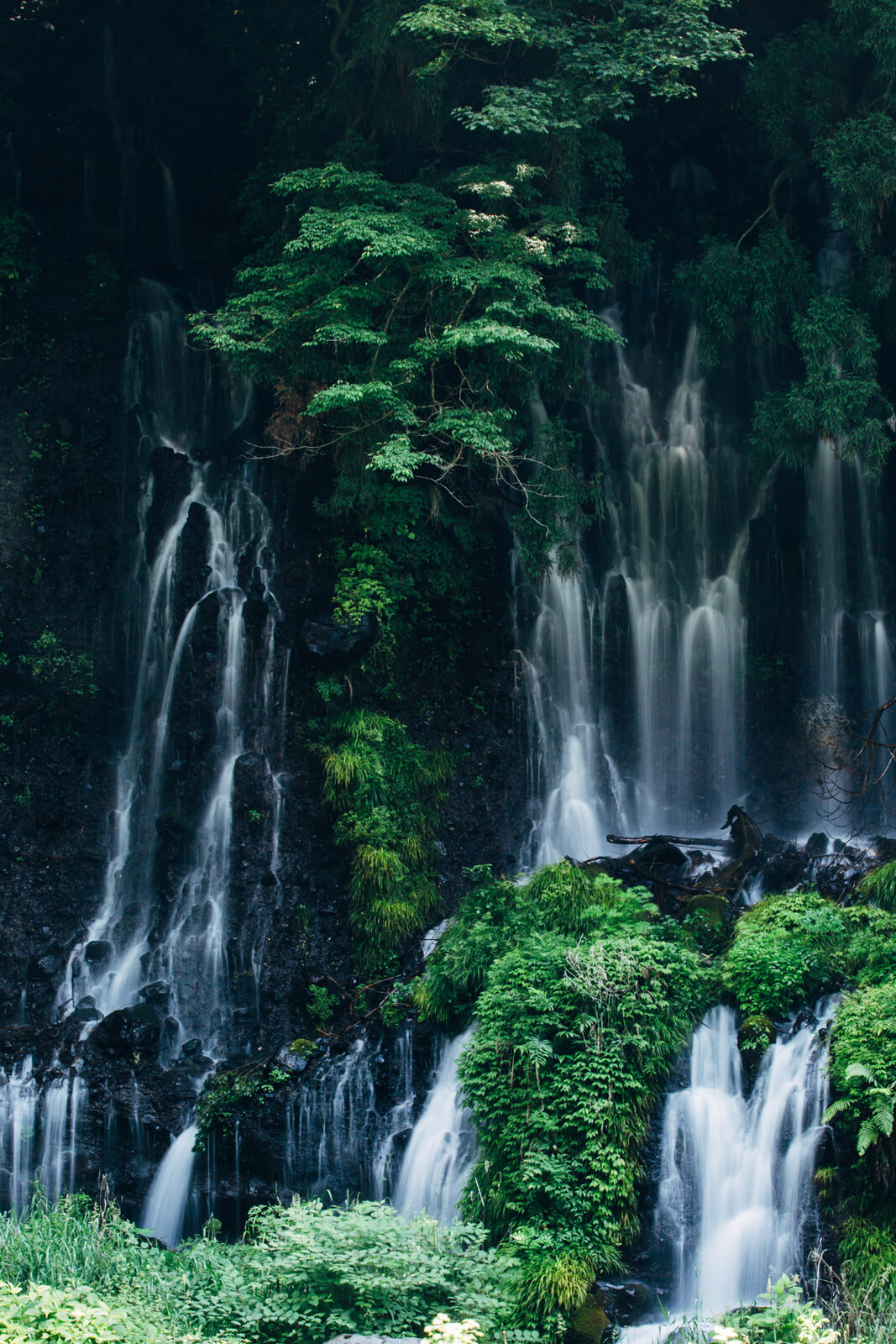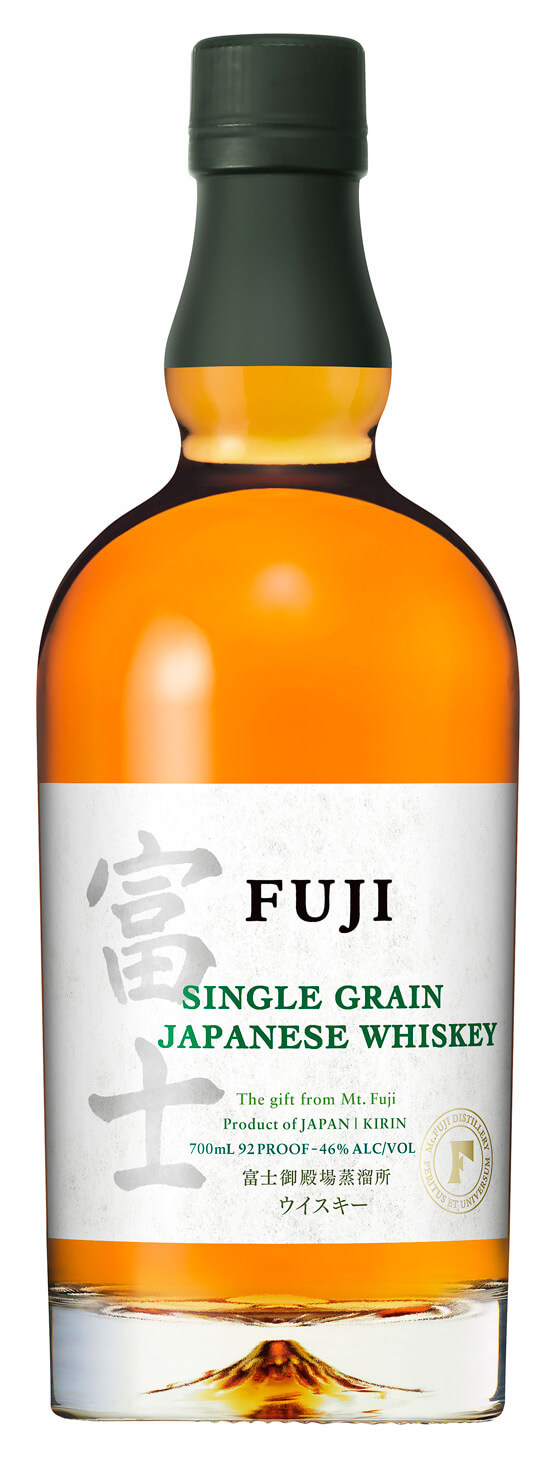I knew immediately we were going to get along. I was preparing for a zoom session with Jota Tanaka, the most highly credentialed distiller and blender working in the Japanese whisky industry today, when the man himself popped up on screen. “Put the whisky aside for a moment”, he suggested, “I understand you are a fly fisherman?”
As it turns out, so is Tanaka. That may not mean a lot to some, but as any fisherman can tell you, especially fly fishermen, put two of us together and you can’t shut us up. In addition, I may have done whisky lovers in New Zealand a great service. Our friend Tanaka loves great brown trout and there is nowhere on earth, at least for me, where brown trout fishing is more exciting than in the northern part of the South Island of New Zealand. I foresee a visit to New Zealand to promote his wonderful whiskies in a new market and perhaps some fishing as well!

Fuji Single Grain Japanese whisky
Before too long, well perhaps too long for his entourage, we turned to whisky and what thrilling new whiskies they are (new to me, at least).
But first, imagine the view out of your office window to be one of the most iconic on the planet. Some people have all the luck.

Mount Fuji viewed from Ōwakudani (photo courtesy Suicasmo/Wikipedia)
The distillery overlooks Mt Fuji (more accurately neighbors the mountain as the distillery sits at 2,000 feet above sea level, at the foot of Mt Fuji, while the peak is over 12,000 feet above sea level). However, Tanaka tells me that for much of the year, clouds and mists obscure the mountain.

Snowmelt water fall from Mount Fuji
Snow is only on the famous peak for less than half the year, in any event, and with climate change, no doubt it will diminish further. Nonetheless, the magnificent mountain plays a crucial role in the production of their whisky, and has no doubt helped bring many visitors to the distillery.
The average temperature here is a chilly 13°C, while the high humidity, averaging around 85%, helps in the aging of the whisky in the barrels. Of course, all this might one day backfire as Mt Fuji is still an active volcano. Fingers crossed.
Tanaka has decades of experience in the whisky industry around the world and has been in charge at the Mt Fuji Distillery since 2017. He is only the second person from Japan awarded the title of Master Blender and has recently been inducted into the prestigious Whisky Magazine ‘Hall of Fame’, only the fourth such inductee from Japan and the only one to receive the award while still working.

Jota Tanaka, master blender at the Fuji Whisky distillery
Tanaka began working with Kirin Brewery (the overall owners of the Mt Fuji Distillery) in 1988, spending time at a Californian winery before completing a Master’s degree in Food Science at the University of California, Davis. He then spent seven years as Director of Quality at the Four Roses Distillery, Kentucky, before returning to Japan in 2009. He was named Chief Blender in 2010, and then Master Blender in 2017, becoming only the second person to hold that post in the 50 years of the Distillery’s history.
Tanaka is also heavily involved in the new whisky regulations, which are partly aimed at ensuring that labeling is accurate and that offshore whiskies are not brought in and labeled as Japanese. There are some distilleries doing this but making it clear on the label, which is fine. It is providing some exceptional whiskies, but there are always some who’ll try and beat the system. It should be noted that the new regulations only apply to members of the Japan Spirit & Liqueurs Makers Association, although that does cover the majority of Japanese producers.
The Distillery, the full title of which was the Fuji Gotemba Distillery and is now Mt Fuji Distillery, was established in 1973, well before the worldwide interest in Japanese whisky took hold, although it was a time when whisky was very popular in Japan. Given the ownership, and their connections around the globe, a unique approach was taken. Here, forget malts. Grains are king.
The Distillery was a joint venture between various related producers, Seagram, Kirin and Chivas Brothers. A number of production techniques from around the globe were incorporated, notably from the USA, Canada and Scotland. As well as Four Roses, Kirin now has such distilleries as Chivas Brothers (Scotland) and Seagram’s (Canada), and much, much more. It was in 2002 that the corporate structure was ‘simplified’ and Mt Fuji became a fully owned subsidiary of Kirin Brewery Company (Seagram’s was once the largest owner of alcoholic beverages on the planet, but by then, had been dismantled).
The importance of the water source for distilleries is well-known and crucial for style and quality. How special, then, for a distillery to have access to the melted snow from Mt Fuji, but only after those waters have spent fifty years filtering their way down to an aquifer 100 meters below the Distillery, for its sole use. Given that this year is the 50th anniversary of the Distillery, it means that the snows which fell on the mountain as it was opened for production, are only now being used to create their whiskies.
Whatever style they may look to, the aim is to produce whisky which is “clean and estery”, while floral and fruity notes regularly emerge across the range. There is depth and complexity and an appealing mellow character across the range to be found in their whiskies.
Before looking at the whiskies specifically, it is worth mentioning that more than any other distillery or blender I have encountered, there is a real emphasis on the different approaches to enjoying and exploring the whisky. Looking at it before one swirls the glass, letting it sit for 10-15 minutes before doing so, and the style of glass are all important. Tanaka is very keen to emphasize all this and more.

Fuji Single Blended Japanese whisky
The glass noted on their site as the pick for their whiskies resembles a top quality sherry glass – not the tiny, ridiculously useless things one often sees used in restaurants. The alternative, which does work extremely well, is the Riedel Veritas Sauvignon Blanc glass. It allows people to see much more of what the whisky has to offer than if they simply picked up the glass, gave it a whirl and drank the contents.

Fuji Single Grain Japanese whisky
Also worth mentioning is that Tanaka is very keen on his whiskies being matched with appropriate food. He is a fan of matching them with chocolate, finding the two make for a great combination. Raw fish is another suggestion. The mind boggles a little at the concept of the one drink being an ideal match for two items as different as chocolate and fish.
Tanaka also suggests that after your initial tasting, a dollop of water will help release the esters and aromas. We discussed a small ice cube instead – it might be 13°C where they usually drink their Mt Fuji, but for me, it is often closer to 30°C and the ice does the same job as it melts, but also helps to keep the liquid fresh. Yes, I have been castigated for such a suggestion before, but I would suggest that everyone needs to indulge in a little experimentation to find what works for them. And for those maintaining a rigid view that all top spirits must be drunk neat, if the blender himself suggests otherwise, perhaps it is time to reconsider, unless you really do think you know better.

Fuji whisky starts with raw grains of ceral
The unique approach taken at the Distillery allows for the production of four types of whisky. A malt whisky, in the style so well-known from Scotland and then three versions of grain whisky, being the American style which resembles Bourbon; Canadian; and also Scotch.
With the grain whiskies, the use of multi-column stills provides for continuous distillation resulting in whisky that is lighter in style, quite delicate. Batch distillation is by kettle and column stills making a more medium, luscious style of whisky, emulating that from Canada. The beer column and Doubler stills also provide continuous distillation but result in the heavier Bourbon-style whiskies. Barrels are usually American white oak and have often been previously used by their sibling distillery, Four Roses. There has been inclusion of a range of sherry barrels in recent times, and also the use of Mizunara oak. The whiskies are bottled at relatively high alcohol levels.
It is fascinating to talk with Tanaka about aging. These days, the trend is very much that the older the whisky, the better it must be. Tanaka is having none of it and refers to his conversations with legendary Wild Turkey blender, Jimmy Russell. It seems that they are on the same page. Tanaka believes that the maturation peak for Bourbon sits between five and eight years. He does not believe that simply aging the barrels endlessly will produce a better product. This is partly why he operates on a No-Age-Statement basis.
Blending becomes key. It is extraordinary how often, when one talks to a master blender of spirits, a chef de cave in charge of great non-vintage champagne, or a top cigar roller that what they have to say almost becomes interchangeable. Blending is an art and it takes many years to achieve the level we see with someone like Tanaka. He aims for complexity, richness, and multi-layered character.
The good news for Australian whisky lovers is that the Mt Fuji range has finally hit the shores. USA, Asia, and the Japanese domestic market are already well catered for, but in Europe, other than Paris, pickings will be slim. They hope to rectify that in time.
The new regulations, as mentioned above, also allowed for what is effectively a new category, the ‘single blend’, as odd as it sounds. Previously, ‘single’ could only apply to a single malt or a single grain. Now, a blend of malt and grain can be known as a ‘single blend’. Mt Fuji sought and attained recognition to use this term, with the support of many other whisky distillers. Outside Japan, there are some similar curiosities in Scotland, more in Ireland and it is quite common in Canada.
Fuji whiskies
Single Grain Whiskey ($150) – A delightfully fresh, almost ethereal style of whisky. Notes of hazelnuts, florals, spices, gentle orange rind, stonefruit, a touch of light chocolate and a hint of caramel. Pears and even the merest hint of cranberries. A touch of honey seeps in on the finish. Layered and with deceptive complexity. Good length and fine balance.

Fuji Single Grain Japanese whisky
The alcohol sits at 46%. This is a whisky that would easily entice one back for a second glass, perhaps more. Mellow is a word that is thrown about a little too easily when it comes to whiskies but here, it seems appropriate. 100% American white barrels were employed.
Please note that the spelling of ‘whiskey’ is not an error. Even though it is traditional in Japan to use the Scottish version, namely ‘whisky’, for this product, the American version has been adopted as a nod to the strong connection that they have with American distilling.
Single Blended Whisky ($180) – Whisky aficionados will surely want to sample this blend of grain and malt, even if only out of curiosity. It is the whisky that has really become the hallmark of the Distillery. It works almost like a sweet and sour dish, a combination of the richer and slightly heavier notes, combined with the lighter, fresher and more delicate contribution from the grains. Most importantly, it works. Not much point in doing it if the resulting whisky is not a good one. This, most certainly, is.
The final result is a layered and complex whisky. More oats and deeper stonefruit notes, with a rich white chocolate touch evident. Red fruits and a hint of a character like a pear custard. A little more honey evident here. Still, some lovely florals, showing that the grains are not overwhelmed. For me, the very first impression was a lovely note of oats, which works wonderfully well. Finely balanced, silky. The deep citrus, an even deeper orange rind note than we saw on the Single Grain, with dried apricots. Thrilling length. The alcohol a smidge lower here at 43%. 4,700 cases made.
Single Blended Masterpiece 2022 Whisky ($1,650) – This was the first ‘single blended’ released, making it a bit of a collector’s item. That would be a shame as it is a whisky that demands drinking. As discussed, Tanaka is more interested in harmony and the degree of maturity, rather than the actual age. That said, there are components here that are over thirty years in age, but that is not the point. The point is to make the best whisky of this style that he could.

Fuji Single Blended Masterpiece Japanese whisky
It is wonderful stuff. Extremely complex, there are notes of chocolate, hazelnuts, spices and honey. We have that teak note sometimes seen in old fortifieds, with dried apricots. Nuanced, elegant and yet full of flavor. Alcohol is at 50%. Some of the barrels used were not their usual – old wine casks and beer barrels have been included. As we explore this whisky, we see more black fruits, cassis, incense and deeper chocolate emerge in waves. A touch of raspberry, but it is the darker fruits that dominate. There is some oak, but it merely works with all the other components and does not intrude. A wonderful whisky, one for the bucket list. Only 1,000 bottles made, apparently 300 of those allocated to Australia. Lucky us.
I very much look forward to catching up with Jota Tanaka in the flesh and not over a machine, at some stage in the future, hopefully with a fly rod in one hand and a glass of great whisky in the other.
For more information, please visit https://fujiwhisky.com/
You might also enjoy:
Yamazaki 12-Year-Old Japanese Whisky: Why Pricing Has Gone Through The Roof
Lark Rare Cask Series Para100 Whisky: Yes, Tasmania Makes World-Class Whisky
Asaka Aoi Edition Single Cask: A Japanese Single Malt Whisky Worth Looking At
Chichibu Whisky: The Japanese Version Of Pappy Van Winkle
<







